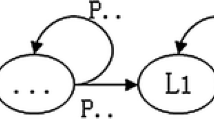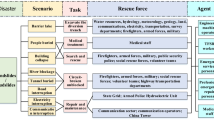Abstract
This paper develops scenario-based stochastic optimization model to choose optimal policies for the integrated deployment of local urban relief teams in the early aftermath of sudden-onset mass casualty incidents. The deployment of local relief teams in an urban area with several affected sites, allocation of casualties to casualty treatment centres, and assignment of medical teams to casualty treatment centres and triage groups are simultaneously determined. Seven strategies under “streaming” and “pooling” groups of treatment strategies are linked to the activity of relief teams. Based on realistic data, our model is analysed for 1750 random samples of the disaster field and 35 instances of a hypothetical earthquake. The results show the integration of SAR and on-field treatment operations can increase the number of survivors. The robust model results in a less number of survivors because it tries to maintain the optimal solution under given scenarios close to its expected value.











Similar content being viewed by others
Notes
It was previously used by other scholars such as Chen and Miller-Hooks (2012).
“g” or “g-force” in geology means the acceleration due to the earth's gravity.
References
Abidi H, De Leeuw S, Klumpp M (2014) Humanitarian supply chain performance management: a systematic literature review. Supply Chain Manag Int J 19(5/6):592–608
Ahmadi G, Tavakkoli-Moghaddam R, Baboli A, Najafi M (2020) A decision support model for robust allocation and routing of search and rescue resources after earthquake: a case study. Oper Res Int J. https://doi.org/10.1007/s12351-020-00591-5
Alem D, Clark A, Moreno A (2016) Stochastic network models for logistics planning in disaster relief. Eur J Ope Res 255(1):187–206
Alexander DE (2002) Principles of emergency planning and management. Terra Publishing, Harpenden and Oxford University Press, New York, NY.
Altay N, Green WG (2006) OR/MS research in disaster operations management. Eur J Ope Res 175(1):475–493
Alizadeh M, Amiri-Aref M, Mustafee N, Matilal S (2019) A robust stochastic Casualty Collection Points location problem. Eur J Ope Res 279(3):965–983
Amateur Seismic Centre (2004) http://asc-india.org/lib/20041226-sumatrahtm. Last visit on June (2018)
Anaya-Arenas AM, Renaud J, Ruiz A (2014) Relief distribution networks: a systematic review. Ann Oper Res 223(1):53–79
Bahadori M, Khankeh HR, Zaboli R, Malmir I (2015) Coordination in Disaster: A Narrative Review. Int J of Med Rev 2(2):273–281
Borden Institute (2013) Mass casualty and triage Emergency War Surgery (4th US revision): Published by the Office of The Surgeon General, Fort Sam Houston, Texas 78234–6100
Bravo RZB, Leiras A, Cyrino Oliveira FL (2019) The use of UAVs in humanitarian relief: an application of POMDP-based methodology for finding victims. Prod Oper Manag 28(2):421–440
Caunhye AM, Nie X, Pokharel S (2012) Optimization models in emergency logistics: a literature review. Socio-Econ Plan Sci 46(1):4–13
Caunhye AM, Nie X (2018) A stochastic programming model for casualty response planning during catastrophic health events. Transp Sci 52(2):437–453
Çelik M, Ergun Ö, Keskinocak P (2015) The post-disaster debris clearance problem under Incomplete Information. Oper Res 63(1):65–85
Chen L, Miller-Hooks E (2012) Optimal team deployment in urban search and rescue. Transp Res B-Meth 46(8):984–999
D’Andrea SM, Goralnick E, Kayden SR (2013) Boston marathon bombings: Overview of an emergency department response to a mass casualty incident. Disaster Med Public Health Prep 7(2):118–121
Dean MD, Nair SK (2014) Mass-casualty triage: Distribution of victims to multiple hospitals using the SAVE model. Eur J Ope Res 238(1):363–373
Doocy S, Daniels A, Packer C, Dick A, Kirsch TD (2013) The human impact of earthquakes: A historical review of events 1980–2009 and systematic literature review. PLOS Currents Disasters Apr 16 Edition 1. https://www.ncbi.nlm.nih.gov/pmc/articles/PMC3644288/
Farahani RZ, Lotfi MM, Baghaian A, Ruiz R, Rezapour S (2020) Mass casualty management in disaster scene: A systematic review of OR&MS research in humanitarian operations. Eur J Ope Res 287(3):787–819
Frykberg ER (2005) Triage: Principles and practice. Scandinavian Journal of Surgery 94(4):272–278
Galindo G, Batta R (2013) Review of recent developments in OR/MS research in disaster operations management. Eur J Ope Res 230(2):201–211
Gu J, Zhou Y, Das A, Moon I, Lee GM (2018) Medical relief shelter location problem with patient severity under a limited relief budget. Comput Ind Eng 125:720–728
Gupta S, Starr MK, Farahani RZ, Matinrad N (2016) Disaster management from A POM perspective: Mapping a new domain. Prod Oper Manag 25(10):1611–1637
Hoyos MC, Morales RS, Akhavan-Tabatabaei R (2015) OR models with stochastic components in disaster operations management: A literature survey. Comput Ind Eng 82:183–197
Independence Day (2014) International Disaster Assistance and Rescue Teams put on alert for major Ebola outbreak in the US in October (2014) http://www.independencedaypro/?p=6703. Last visit on June (2018)
Jacobson EU, Argon NT, Ziya S (2013) Priority assignment in emergency response. Oper Res 60(4):813–832
JICA (Japan International Cooperation Agency) (2000) The Study on Seismic Micro zoning of the Greater Tehran Area in the Islamic Republic of Iran Centre for Earthquake and Environmental Studies of Tehran (CEST): Pacific Consultants International OYO Corporation. Municipality, Tehran
Jin S, Jeong S, Kim J, Kim K (2015) A logistics model for the transport of disaster victims with various injuries and survival probabilities. Ann Oper Res 230(1):17–33
Kamali B, Bish D, Glick R (2017) Optimal service order for mass-casualty incident response. Eur J Ope Res 261:355–367
Leiras A, De Brito JI, Queiroz Peres E, Rejane Bertazzo T, Tsugunobu Yoshida Yoshizaki H (2014) Literature review of humanitarian logistics research: trends and challenges. J Hum Logist Supply Chain Manag 4(1):95–130
Li D, Glazebrook KD (2010) An approximate dynamic programming approach to the development of heuristics for the scheduling of impatient jobs in a clearing system. Nav Res Logist 57(3):225–236
Liu Y, Cui N, Zhang J (2019) Integrated temporary facility location and casualty allocation planning for post-disaster humanitarian medical service. Transport Res E-Log 128(April):1–16
McGuigan DM, Deam BL, Bull DK (2002) Urban search and rescue and the role of the engineer. In: NZSEE 2002 Conference. Department of Civil Engineering. University of Canterbury. https://www.nzsee.org.nz/db/2002/Paper44.PDF
Mills AF, Argon NT, Ziya S (2013) Resource-based patient prioritization in mass-casualty incidents. Manuf Serv Oper Manag 15(3):361–377
Mills AF (2015) A simple yet effective decision support policy for mass-casualty triage. Eur J Ope Res 253(3):734–745
Mulvey J, Vanderbei R, Zenios S (1995) Robust optimization of large-scale systems. Oper Res 43(2):264–281
Nateghi-A F (2001) Earthquake scenario for the mega-city of Tehran. Disaster Prev Manag Int J 10(2):95–101
Niessner H, Rauner MS, Gutjahr WJ (2017) A dynamic simulation–optimization approach for managing mass casualty incidents. Oper Res Health Care 17:82–100
Oksuz Mk, Satoglu SI (2020) A two-stage stochastic model for location planning of temporary medical centers for disaster response. Int J Disaster Risk Reduct 44 (April 2020):101426
Olson RS, Olson RA (1987) Urban heavy rescue. Earthq Spectra 3(4):645–658
Özdamar L, Ertem MA (2015) Models, solutions and enabling technologies in humanitarian logistics. Eur J Ope Res 244(1):55–65
Pan F, Nagi R (2010) Robust supply chain design under uncertain demand in agile manufacturing. Comput Oper Res 37:668–683
Ramezankhani A, Najafiyazdi M (2008) A system dynamics approach on post-disaster management: a case study of Bam earthquake. In: Conference Proceedings of the 2008. International Conference of System Dynamics Society 20–24
Rauchecker G, Schryen G (2019) An exact branch-and-price algorithm for scheduling rescue units during disaster response. Eur J Ope Res 272(1):352–363
Rezapour S, Naderi N, Morshedlou N, Rezapourbehnagh S (2018) Optimal deployment of emergency resources in sudden onset disasters. Int J Prod Econ 204:365–382
Rodriguez-Espindola O, Albores P, Brewster C (2018) Disaster preparedness in humanitarian logistics: a collaborative approach for resource management in floods. Eur J Ope Res 264(3):978–993
Sabouhi F, Tavakoli ZS, Bozorgi-Amiri A, Sheu JB (2019) A robust possibilistic programming multi-objective model for locating transfer points and shelters in disaster relief. Transportmetrica a: Transport Sci 15(2):326–353
Sacco WJ, Navin DM, Fiedler KE, Waddell RK, Long WB, Buckman RF (2005) Precise formulation and evidence-based application of resource-constrained triage. Acad Emerg Med 12(8):759–770
Sacco WJ, Navin DM, Waddell RK, Fiedler KE, Long WB, Buckman RF (2007) A new resource-constrained triage method applied to victims of penetrating injury. Journal of Trauma Acute Care Surgery 63(2):316–325
Saghafian S, Hopp WJ, Van Oyen MP, Desmond JS, Kronick SL (2012) Patient streaming as a mechanism for improving responsiveness in emergency departments. Oper Res 60(5):1080–1097
Salman FS, Gül S (2014) Deployment of field hospitals in mass casualty incidents. Comput Ind Eng 74(1):37–51
Smith W, Wallis L (2012) Triage in mass casualty situations. Int Hosp Equipm Solutions 30(11):413–415
Sun Z, Argon NT, Ziya S (2017) Patient Triage and Prioritization Under Austere Conditions. Manage Sci 64(10):4471–4489
Sun H, Wang Y, Zhang J, Cao W (2021a) A robust optimization model for location-transportation problem of disaster casualties with triage and uncertainty. Expert Syst Appl 175: 114867.
Sun H, Wang Y, Xue Y (2021b) A bi-objective robust optimization model for disaster response planning under uncertainties. Comput Ind Eng 155(99): 107213.
Venkat A, Kekre S, Hegde GG, Shang J, Campbell TP (2015) Strategic management of operations in the emergency department. Prod Oper Manag 24(11):1706–1723
Wex F, Schryen G, Feuerriegel S, Neumann D (2014) Emergency response in natural disaster management: allocation and scheduling of rescue units. Eur J Ope Res 235(3):697–708
Wilson DT, Hawe GI, Coates G, Crouch RS (2013) A multi-objective combinatorial model of casualty processing in major incident response. Eur J Ope Res 230(3):643–655
Wilson DT, Hawe GI, Coates G, Crouch RS (2016) Online optimization of casualty processing in major incident response: an experimental analysis Duncan. Eur J Ope Res 252(1):334–348
Yu C, Li H (2000) A robust optimization model for stochastic logistic problems. Int J Prod Econ 64:385–397
Zhang S, Guo H, Zhu K, Yu S, Li J (2017) Multistage assignment optimization for emergency rescue teams in the disaster chain. Knowl-Based Syst 137:123–137
Author information
Authors and Affiliations
Corresponding author
Additional information
Publisher's Note
Springer Nature remains neutral with regard to jurisdictional claims in published maps and institutional affiliations.
Rights and permissions
About this article
Cite this article
Baghaian, A., Lotfi, M.M. & Rezapour, S. Integrated deployment of local urban relief teams in the first hours after mass casualty incidents. Oper Res Int J 22, 4517–4555 (2022). https://doi.org/10.1007/s12351-022-00689-y
Received:
Revised:
Accepted:
Published:
Issue Date:
DOI: https://doi.org/10.1007/s12351-022-00689-y




